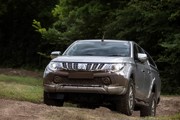Review
Mitsubishi has given the L200 pick-up a thorough going-over to give it a tougher look and improve its efficiency.
Externally much has changed. The front end now resembles the latest Mitsubishi family face, has sharper looks and a raised bonnet line to increase its road presence.
Under said bonnet is a new engine. It’s smaller than the old one at 2.3-litres and a bit less pokey with 150PS. However, Mitsubishi says the power and torque (400Nm) are delivered at lower revs, therefore improving driveability and, actually, the power deficit isn’t really noticeable.
The new engine also meets the latest Euro 6d emissions regulations and should easily manage 32mpg.
The L200 is not break-neck fast – you’ll need a Volkswagen Amarok for that – but it delivers a decent response to prods of the throttle and is unlikely to disappoint those used to the regular crop of pick-ups.
Refinement is an area the manufacturer wanted to focus on heavily in this revision, and the new L200 is about as car-like as you can make a pick-up with leaf spring suspension.
On A-roads, it feels fairly smooth, although switching to 4WD – which can be done on-the-fly at speeds up to 62 mph – appeared to make things a bit more jiggly.
Road noise isn’t a problem for those that travel long distances and is likely to depend on what tyres are fitted more than poor cabin insulation.
The steering is a little heavy at low speeds and a bit wayward at higher speeds, although we expect the latter is because our test vehicle had no load in the back.
 Overall, the L200’s interior impressed us, the well-appointed higher-spec models certainly makes you think twice about how realistic a pick-up would be as a replacement for a company car, let alone a commercial vehicle – especially considering the BIK tax of less than £60 per month.
Overall, the L200’s interior impressed us, the well-appointed higher-spec models certainly makes you think twice about how realistic a pick-up would be as a replacement for a company car, let alone a commercial vehicle – especially considering the BIK tax of less than £60 per month.
While the new model is festooned with posh trim choices, alloy wheels and colour-coded bumpers, Mitsubishi promises there is no detriment to the pick-up’s “workability” and to prove it bosses were happy for us to put the L200 through its paces on a challenging off-road course.
Despite being waterlogged and the truck being fitted with road tyres, it made mince-meat of the course with its all-wheel drive system and locking differentials providing all the traction we needed.
Its strengthened chassis and stronger brakes provide a payload increase from 1,045kg to 1,080kg, while it also has one of the highest gross train weights in the pickup segment at 6,155kg. That means it can not only tow 3.5-tonnes, it can also carry 620kg of payload at the same time.
Driver assistance systems are fitted to the range-topping versions, bringing autonomous braking, lane keeping aids and blind spot monitoring.
Mitsubishi’s updates have made the L200 more desirable, better to drive and more efficient. It’s akin to large SUV rather than an outright commercial vehicle, yet we’d have no concerns about its ability in a tough working environment.
Specs
| Manufacturer | Mitsubishi |
| Model | L200 Light Commercial |
| Specification | L200 PickUp DoubleCab 4wd 2.2DI-D 150 DPFR SS €6 Warrior 6Spd 20MY |
| Model Year | 0.00 |
| Annual VED (Road tax) | £0 |
| BIK List Price | £26,355 |
| CO2 | 231g/km |
| Insurance Group | N/A |
| CC | N/A |
| Fuel Type | |
| Vehicle Type | Pick-up |
| Luggage capacity (Seats up) | 5litres |
Running Costs
| P11D | £26,355 |
| Insurance group | N/A |
| Fuel Type | |
| Cost per mile | 61.11ppm |
| Fuel | 18.34ppm |
| Depreciation | 35.86ppm |
| Service maintenance and repair | 6.91ppm |
Rivals
Info at a glance
-
P11D Price
£26,355
-
MPG
32.1 -
CO2 Emissions
231g/km -
Payload
1,155kg -
Load Volume
N/A -
Load Width
1,470mm -
Load Length
1,520mm













 Diesel
Diesel












